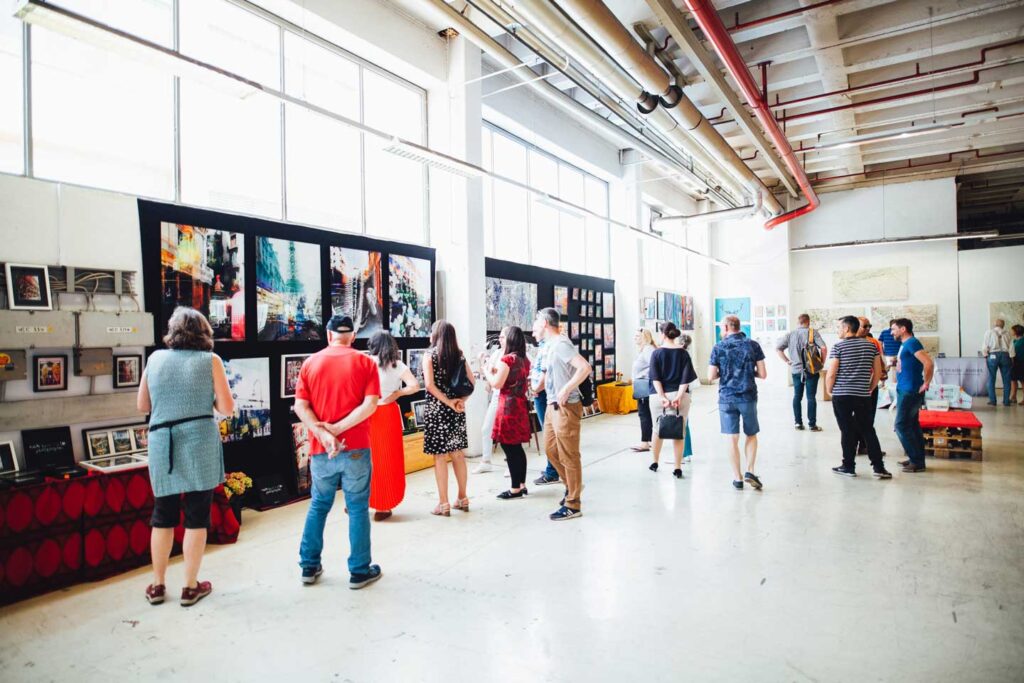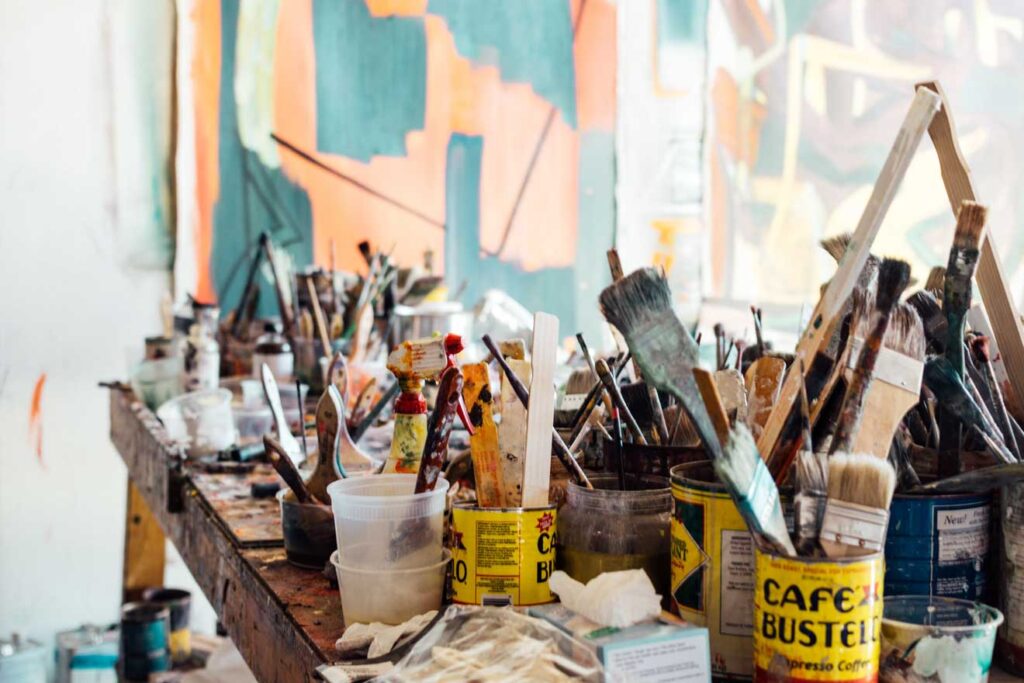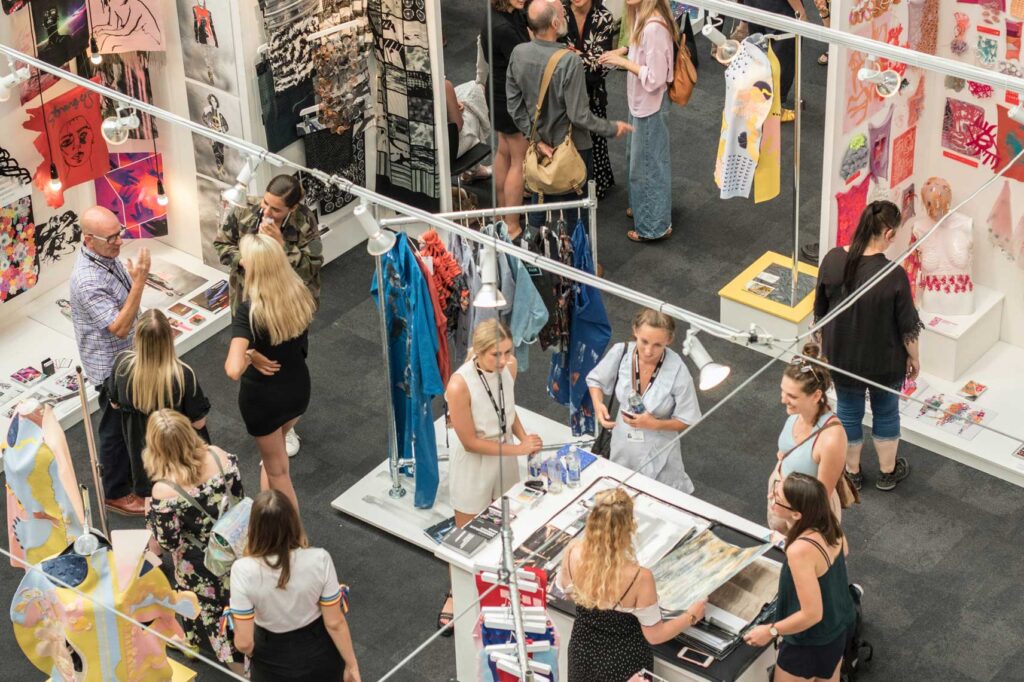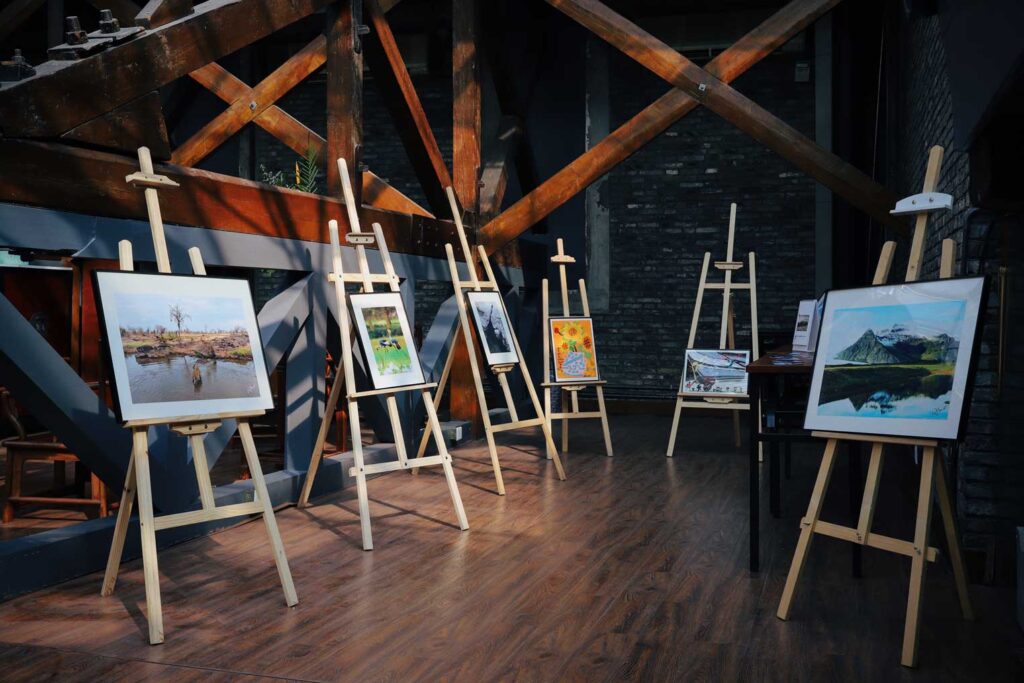How to Make a Living as an Artist in Australia: Step-by-Step Guide
Making a living from your art is possible for an Australian artist, but it’s going to take time, hustle and dedication. From selling art online in Australia to Australian grants and incentives, in this article we’ll cover it all. We’ll break down the various revenue streams available for artists and designers, and map out an actionable plan to get you making art full time.
Table of Contents
Why be a full time artist?
There are many reasons why you might want to make the switch to being a full-time artist. Maybe you feel like you’re not reaching your full potential working a day job, or maybe you simply love creating your own brand of art and can’t imagine doing anything else. Whatever your motivations, know that it is possible to make a living from your art in Australia – but it will take hard work.
Here are some of the pros and cons of creating art full time:
Pros:
- You get to wake up every day and do something you’re passionate about
- There’s a lot of freedom and flexibility in terms of your schedule
- You get to be your own boss
- You can make a real difference in the world through your art
- Work remotely from anywhere in the World
Cons:
- It can be a very unstable income
- You have to wear many hats, from marketing to sales to accounting
- It can be isolating working by yourself
- You have to hustle hard to make it work
- Selling art online is like running a business
Both of these lists could easily be three of four times longer but ultimately what it all boils down to is the age-old Freedom VS Security conundrum. Unless you’ve already got money saved, the freedom to follow your passion and create the art you want to create is going to cost you in financial security. There’s simply no avoiding it.
If I haven’t scared you off yet, let’s delve into how it can be done.

Revenue streams for artists in Australia
As an artist or designer, there is a seemingly unlimited number of different revenue streams available but generally these ones tend to be the most lucrative.
- Licensing your art
- Commissions
- Online art sales
- Offline art sales
- Retail partnerships
- Art residencies and fellowships
- Grants and incentives
- Patrons and crowdsourcing
- Workshops and Teaching
Let’s take a more detailed look at each of these in turn.
Licensing your art
One way to make money from your art is to license it out for use in other products or media. This could be anything from phone cases to t-shirts to blog articles to advertisements. When you license your art, you retain the copyright but allow someone else to use it for a specific purpose in return for a fee. This is usually a one-time payment but can sometimes be an ongoing royalty.
There are literally dozens of great stock image sites and creative content marketplaces that enable you to license your work directly to the public. These include:
- Shutterstock
- iStockphoto
- Getty Images
- Adobe Stock
- Dreamstime
- Fotolia
- Envato
- and many others
Platforms like these enable you to not only license images but also website templates, music, videos, After Effects templates, and much more.
To succeed on these types of platforms, you need to have a good understanding of what types of content are in demand and upload a steady stream of high-quality, keyword-optimised photos, illustrations or videos.
Top earners on these stock platforms can make hundreds or even thousands of dollars per month but it takes time and consistency to build up a large enough portfolio to make serious money.
Commissions
A commission is when someone hires you to create a specific artwork for them. This could be anything from a portrait to a landscape to a mural. Commissions are one of the oldest ways for artists to make a living, with the first recorded commission dating back to the 13th century. Great artists like Leonardo da Vinci, Rembrandt, and Vincent van Gogh all made the majority of their income from commissions.
Nowadays, you don’t have to be a master painter to get commissions. In fact, with the rise of social media, it’s easier than ever for regular people to connect with artists and hire them to create custom artwork.
There are a number of ways to find commission work:
- You can actively seek it out by contacting people directly and pitching your services.
- You can list your services on online marketplace platforms like Fiverr, Upwork, or 99designs.
- You can set up an online shop and include a “commission” option for interested buyers.
- Or it can be as simple as adding ‘Commissions open’ to your Instagram bio.
The great thing about commissions is that you can set your own prices and there is no limit to how much you can earn. The downside is that they can be time-consuming and you may have to compromise on your creative vision to meet the client’s needs.
Unlike licensing, when you take on a commission you do not retain the copyright to the artwork, meaning the client can do whatever they want with it once it’s finished. So, if you’re planning on selling the artwork in the future, make sure you get explicit permission from the client beforehand.
A relatively new or ‘undiscovered’ artists can charge anywhere from $50 – $500 per artwork, depending on the size, medium, and complexity. Once you’ve built up a strong portfolio and a good reputation, you may be able to charge $1,000 or more.

Selling art online in Australia
If you want to sell art online Australia is a great place to do it. With a thriving art community, an abundance of fulfilment options and sophisticated collectors, there are plenty of opportunities for artists to make a living from their artwork. Australians are also lucky enough to have a financial safety net in the form of Centrelink and the NEIS program. The number of creative businesses made possible by these funding sources is staggering, but more on than later.
There are various routes you can take to sell your original art. From setting up your own eCommerce website to listing your work on established online marketplaces, there are a number of ways to reach buyers both in Australia and around the world.
Some of the most popular online marketplaces to sell art online include:
- Etsy
- Pikcha
- Artfinder
- Saatchi Art
- Redbubble
- And Society6
Each platform has its own set of pros and cons, so it’s worth doing your research to see which one is the best fit for you. For example, Etsy is great for selling handmade goods and limited edition prints, while Redbubble is better for digital art and Society6 focuses on home decor items like bedding, mugs and phone cases. Pikcha focuses more on the photographic arts and signed prints, whereas Saatchi Art and Artfinder are better for selling original paintings.
When it comes to making money as an artist, your ability to sell art online in Australia and abroad will likely be fundamental to your success.
As an unknown artists without a pre-existing audience, you will not earn much from online sales initially. In fact, you may even make a loss in the early days as you invest in marketing and promotion. However, if you are strategic about it and build up a strong online presence on one or more of these platforms, you may eventually make a full-time living from your artwork sales alone.
Successful Etsy artists, for example, have been reported to make over $100,000 per year. But it’s important to remember that most of these artists have been at it for years, slowly building up their customer base and perfecting their craft.
Note that these platforms take a commission from your sales, so make sure you factor that into your pricing strategy. For example, Etsy charges a 3.5% transaction fee, while Redbubble and Society6 take a 20% cut.
Another option for selling art online in Australia is to set up your own eCommerce website. This gives you full control over the sales process and allows you to keep 100% of the profits, but it also requires a significant investment of time and money.
Selling art offline in Australia
Alternatively you may choose to take the more local route and exhibit your work in physical galleries and shows. This can be a great way to get your name out there and connect with potential buyers, but it’s important to remember that galleries will take a commission on any sales, so you’ll need to factor that into your pricing.
Getting your work into prestigious galleries can be very difficult, but there are other opportunities to exhibit your work in more accessible venues. For example, many cafes and small businesses are on the lookout for new artwork to brighten up their walls, and there are often calls for submissions online.
You can also put on your own shows, either alone or in collaboration with other artists. This can be a great way to get your work out there and piggyback off each other’s audiences.
Another option is to sell your work at local markets or fairs. This can be a great way to connect with your community and build up a local following. You’ll need to invest in a good quality display setup and market your stall effectively to stand out and draw in customers.

Retail partnerships
Another avenue to explore is partnering with local retailers who sell products complementary to your art. For example, if you sell abstract landscape paintings, you could approach a home decor store and offer to sell your work on consignment. This means they get to display your artwork in their store and take a commission on any sales, while you get exposure to a whole new group of potential customers.
It’s also worth considering whether your work would be a good fit for any national or international retailers. If you make products like homewares or fashion accessories, you could approach companies like Myer or David Jones and offer to sell your work in their stores. These companies provide opportunities for many Australian artists and designers, but they are very competitive, so make sure your work is of the highest quality and well-presented before approaching.
How to get an audience with Myer as an artist:
- Research what sort of products Myer sells and consider whether your work would be a good fit. Make sure your work is of the highest quality and well-presented.
- Approach the company with a professional proposal outlining your work and why you think it would be a good fit for their stores. Try reaching out to Myer buying staff on LinkedIn or just call the company directly and ask who need to speak to.
- Be prepared to negotiate on things like price, commission
- If they are interested, follow up with samples of your work and a price list.
- Be prepared to negotiate on price and terms, and remember that Myer will take a commission on any sales.
You may be able to get your foot inside the door by joining their Sell on Myer program. This is their online marketplace but it could lead to in-store opportunities. It enables you to sell art online Australia under the Myer umbrella.
Of course Myer is just one of many retail companies in Australia, so it’s worth doing your research and approaching any that you think might be a good fit for your work.
Art residencies and fellowships
Another avenue to explore is applying for art residencies and fellowships. These programs provide opportunities for artists to live and work in new environments, often with access to resources and mentorship that can help further their careers.
There are many residencies and fellowships available, both in Australia and internationally, so it’s worth doing your research to see what might be a good fit for you.
Some residencies and fellowships are very competitive, so it’s important to put together a strong application. Make sure you include examples of your work, a detailed proposal outlining what you hope to achieve during the residency, and letters of support from relevant people in your field.
Some of the most well known artist residency programs in Australia include:
– The Kerrie Lowe Gallery Residency
– The National Gallery of Victoria Artists Residency
– The Bundanon Trust Artist in Residence Program
For a comprehensive list of programs from around Australia visit https://visualarts.net.au/communities-practice/resources/studio-residencies/list-studios-residencies/
While residencies don’t typically pay artists a salary, they can provide a stipend to help cover costs, as well as access to resources that can be invaluable to furthering your career.
Grants and incentives
There are a number of grants and incentives available to help artists make a living from their work. These can provide much needed financial assistance, as well as helping to build your profile and connect you with new opportunities.
Some of the most well known grant programs for artists in Australia include:
– The Australia Council for the Arts Grants Program
– The Copyright Agency Cultural Fund
– Create NSW Artist Fellowships
For a comprehensive list of grants and incentives visit https://www.arts.gov.au/funding-and-support
As with residencies, competition for grants and government funding can be fierce. Being successful at winning grants is a big topic and one you’ll find plenty of information about online.
Grants typically total a few thousand dollars, but some can be worth much more. They can be used to cover a wide range of expenses associated with your art practice, from materials and equipment, to travel and marketing costs. Make sure the potential payday is worth the time investment when applying for grants.
Patrons and crowdsourcing
Patronage for an artist means having someone who is willing to provide financial support for your work, often in exchange for access to exclusive content or experiences.
It’s a revenue model as old as art itself with many of the greats like da Vinci, Michelangelo and Rembrandt having wealthy patrons who helped to fund their work and careers.
Arts funding through patrons has had a massive resurgence recently with the democratisation of many of the creative industries and rise of platforms like Patreon. These online platforms allows people to support creators they love with recurring monthly payments.
Crowdsourcing is similar to patronage, but instead of one person or organisation providing financial support, it comes from a large group of people, often in exchange for rewards.
The most well known crowdfunding platform is Kickstarter, but there are many others available, including:
- Pozible
- Indiegogo
- Chuffed
Crowdsourcing can be a great way to fund specific projects or even your entire art practice. It’s important to remember that a successful campaign takes a lot of work, so make sure you’re prepared before you launch.
As an unknown artist, running a crowdfunding campaign without doing the exhausting preparation and marketing work is a complete waste of time. So, only give crowdsourcing a go if you are willing to invest significant time and energy into it. Alternatively you could hire someone who specialises in setting up Kickstarter campaigns. Make sure you do your research though and check references to ensure they can do what they say they can do.
With a patronage or crowdfunding campaign you won’t be selling art online per se but instead you’ll be essentially pre-selling art or other perks.
Mid-level artists on Patreon can earn a few hundred to a few thousand dollars per month from their patrons. The top performers are making six figures or more.
A successful Kickstarter campaign can pull in hundreds of thousands of dollars, but the vast majority make much much less.

Workshops and Teaching
It is not uncommon for artists to fund their lifestyles and practices through teaching workshops. Workshops are a great way to not only earn an income, but also to connect with other creatives and build your profile.
There are many ways to go about setting up and running a workshop. You could approach local galleries or community centres and see if they would be interested in hosting one of your workshops. Many artists also run workshops from their own studios or homes.
Teaching art or design classes at TAFE or PACE is a great way to earn a steady income while also getting hands-on experience teaching. These roles are usually very competitive, so make sure you have a backup plan for if it doesn’t work out with TAFE.
If you’re not quite ready to lead your own workshop, you could look into teaching assistant roles or working for an organisation that already runs art classes and workshops.
There is also the option of teaching online courses. This can be a great way to reach a global audience and earn a higher income than you would from teaching in-person workshops. It takes a lot or work to write and setup an online course, but once it’s live it can provide a passive income stream for years to come.
Just like selling art online in Australia there are also plenty of platforms for selling art courses.
Some platforms that offer online courses include:
- Skillshare
- Udemy
- CreativeLive
Artists will typically charge around $100-$200 per person for a half day workshop, with full day workshops costing closer to $300 per person. Of course, the price will depend on the length of the workshop, the material costs, your location, and the level of experience you have.
You can charge online students anywhere from $50-$500 per course, depending on the length and complexity of the course. The most successful online art courses make millions of dollars per year.
Creating an art business plan
As an artist, it’s important to have a business plan. This will help you define your goals, target market and how you’re going to make money from your art. Without a plan, no matter how talented you are, it will be very difficult to make a living from your art.
There are many templates and resources available online to help you create a business plan. Once you have a plan in place, make sure you review it regularly and update it as needed.
Creating a business plan can be daunting, but there are plenty of resources available to help you get started. We highly recommend this article from Growthink which includes a stop by step break down and business plan template: https://www.growthink.com/businessplan/help-center/artist-business-plan
Typically an artist business plan will contain the following:
- An overview of your business and what you do
- Your goals and objectives
- Your target market
- Your marketing and sales strategy
- Your pricing strategy
- Your financial projections
- A SWOT analysis
This is a big topic in itself, so we won’t go into too much detail here. But, check out the resources above for guidance on the creation of your business plan and make sure you have one.
Marketing and selling your art
There are many ways to market and sell your art. The most important thing is to make sure you’re targeting the right audience for your work. There’s no point in trying to sell abstract paintings to someone who only collects landscapes.
Here are some common ways to market and sell your art:
Setting up a website or online shop: This is a great way to reach a global audience and sell your work 24/7. Make sure your website is optimised for search engines and that you’re using effective marketing techniques to drive traffic to it. Selling art online in Australia and around the world is all about getting eyeballs on your work
Social media: Platforms like Instagram, Facebook and TikTok are essential for artists these days. Use them to show off your work, engage with potential customers and build up a following.
Art fairs and exhibitions: These are great places to sell your work, but can be expensive to participate in. Make sure you do your research before committing to anything. Exhibitions can be a great alternative to selling art online due to the fact that they bring their own audience to you without requiring you to do as much marketing.
Private commissions: This is a great way to earn a higher income from your art. Focus on building up a clientele of people who are willing to pay top dollar for your work.
Public art: There are many opportunities for artists to display their work in public spaces. This can be a great way to get exposure and build up a following.
It also pays to get creative and think outside the box. You are an artist after all and creativity is your strong suit!
Here are some interesting and innovative ways artists have launched their careers in the past:
- Organising pop-up exhibitions in public spaces
- Collaborating with other artists and creatives
- Creating art installations
- Working with businesses on murals or other commissioned work
- Taking part in artist residencies
Banksy: The world-famous street artist started out by selling his work on the streets of London. He has since gone on to sell his work for millions of dollars at auction.
Yayoi Kusama: The Japanese artist is known for her iconic polka dot patterns. She started out by giving away free polka dot stickers and selling them at art fairs. She is now one of the most successful artists in the world.
Ai Weiwei: The Chinese artist and activist is known for his provocative artworks. He has used his art to campaign against the Chinese government, which has led to him being arrested and detained on multiple occasions.
JR: The French street artist started out by wheat pasting enlarged photographs of faces in public spaces. He has since gone on to win the TED Prize and been commissioned to create artworks all over the world.
In the digital age there are even more ways to reach your potential audience like:
- Put your art in the various metaverse spaces that are popping up all over the internet or create an augmented reality art installation.
- Work with social media influencers to create a viral trend involving your art and get your work in front of a wider audience.
- Use data-driven marketing techniques to target potential customers with ads for your art.
- Join art communities and forums and participate in conversations there with other artists and art fans. Just be careful not to spam these communities with self-promotion. Always try to give more than you take in these threads and build a following organically.
There is no one-size-fits-all approach to marketing your art. The important thing is to get your work out there and start selling it. The more you sell, the more exposure you’ll get and the easier it will be to make a living from your art.
Formatting your art for sale
You you format and package up your artworks is also important. Some buyers won’t be able to afford an original oil painting, for example, but they might be willing to buy a print or postcard.
Many artists also choose to sell art online as digital downloads that can be printed out at home. This is a great way to make your art more affordable and accessible to a wider audience.
You may even want to delve into the crypto market and turn your art into NFTs.
Either way, make sure your work is well- photographed or digitised so potential buyers can get a good idea of what they’re buying.
Getting an agent
Finding an agent that will take you on as a new artist may be tricky, but if you have a few wins under your belt, this may help to kick your career up to the next level.
Here’s a quick video by illustrator Anoosha Syed about deciding if you need an agent:
Parting words of wisdom
Making a living as an artist in Australia is possible, but it’s not going to be easy. It takes time, dedication and a lot of hard work. But if you’re passionate about your art and willing to put in the effort, it can be a very rewarding career.
Believe it or not, people do find a way to spend their days creating art. So go out there and start selling your art! You never know where it might take you.


